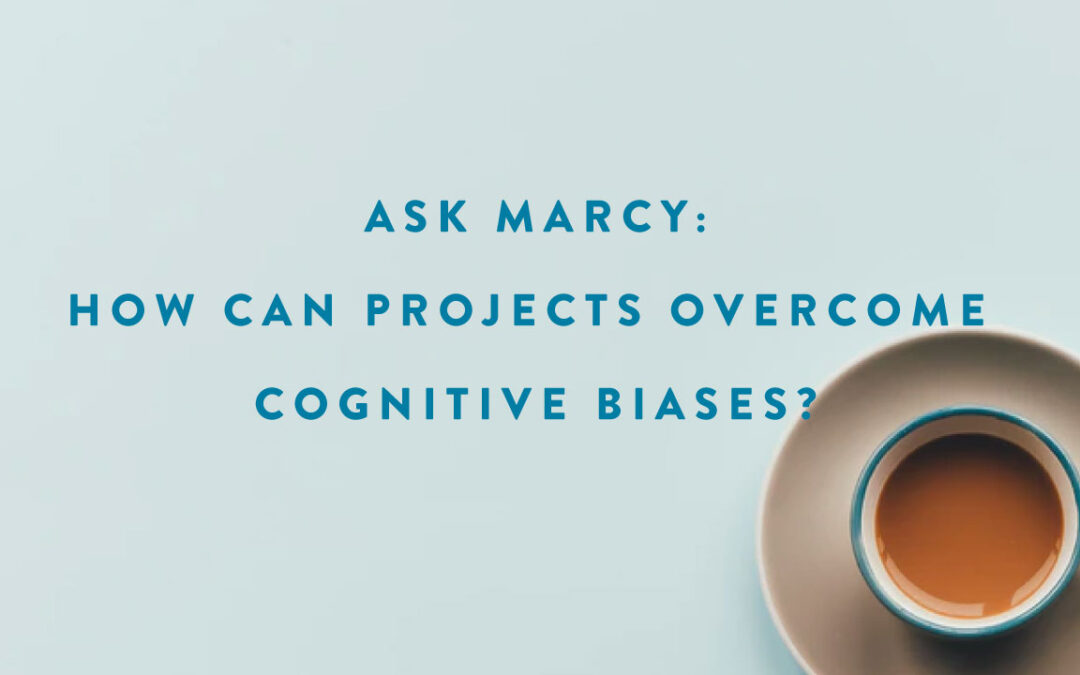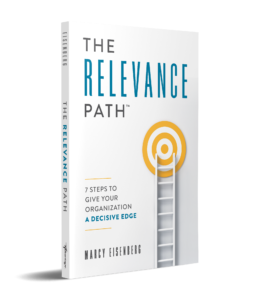This post is part of a series called “Ask Marcy,” where The Relevance Path Readers can submit questions directly to our author, Marcy Eisenberg.
During our book launch party, Alec asked, “Can you share a couple of the wonderful and relevant paths you write about in this awesome book?”
Marcy enthusiastically responded with, “Great question. Thank you, Alec! What’s really unique about the Relevance Path and what everybody’s been saying to me, both in industry, outside of this industry, people in the commercial world, it’s been really incredible, and it’s something that I’ve always felt very personal about, is that we do something different in Relevance. We actually focus on exploring cognitive biases.”
In that moment we knew that we had so much more to say about cognitive biases. While we couldn’t go deep during the virtual event, we thankfully have this blog as a platform to expand on this topic. Here we go!
What is Cognitive Bias?
A cognitive bias is a systematic error in thinking that occurs when people are processing and interpreting information in the world around them and affects the decisions and judgments that they make. We dive deep into examples of cognitive biases in The Relevance Path: 7 Steps to Give Your Organization a Decisive Edge such as:
- Stereotype Bias: a collective tendency as humans to be swayed by people who appear authoritative on topics that individuals, teams, or organizations are not familiar with. This results in humans readily accepting concepts presented on new topics that an individual, team, or organization knows little about, whether those concepts are accurate or not.
- Example: Many of our clients assume the cloud is the answer for all computer security problems, a common stereotype because of the buzz surrounding a new concept. The reality is the cloud has its own set of security ramifications due to the complexity of cloud architecture, development, and maintenance. There are still hardware and software vulnerabilities and access control concerns with the cloud.
- How to overcome the stereotype bias in any project: Use the Quick Wins Risk Analysis and/or Solutions Relevance Review to identify how risky or impactful the preconceived notion is on project success.
- Status Quo Bias: individuals, teams, or organizations perceive anything outside the current state as a loss. Change is almost always perceived as negative and is an irrational preference to one’s current situation.
- Example: It is generally accepted that people hate change. Change is new and scary. The status quo is safe and comfortable, but change is inevitable. Many of our clients fight a change in the status quo when a new process or software application is implemented. Even when the new “thing” is going to make their jobs easier or allow them to work more efficiently, it’s still a change.
- How to overcome the status quo bias in any project: Use the Relevant Solutions Pathmap to easily and efficiently create a time-phased view of the benefit of moving forward on a particular project path.
- Loss Aversion: when a person, team, or organization focuses on change (even if it’s positive) as a loss versus a gain, irrespective of an overall event outcome.
- Example: We have all had a friend, person, or even ourselves, felt absolutely paralyzed by the thought of change. The paralysis could come from a fear of the unknown. It could also derive from a fear of losing (job, reputation, money, control, whatever is important to the person, friend, colleague, or client). This paralysis feeds into a lack of confidence to identify the way forward, which for projects, usually ends in project failure.
- How to overcome loss aversion bias in any project: Identify the value types and value profiles of those affected by a change. Then, use the Solutions Valuation Review to demonstrate the value of a proposed change or solution, in “value terms” that matter to those affected by the change. This will make sure that people involved and affected care about the change, and understand why the change can be a gain, not a loss.
- Change Blindness: people are so unaware of their surroundings that real changes in their environment often go completely unnoticed.
- Example: A new software version update is rolled out, and it has huge changes, but the users don’t realize those changes (either because they don’t use those features, or just didn’t recognize something is different).
- How to overcome change blindness bias in any project: Use the Relevant Solutions Pathmap to easily and efficiently create a time-phased view of where a project was in the past, where it is right now, and where potential solutions will get a project. This will clearly show how the project is changing, and how it will change for the better.
- Anchoring Effect: clinging to initial information received above all else.
- Example: Similar to status quo bias, this concept ties into the resistance to change. Changing a person’s understanding of something can often be harder than changing how they do it. Their original understanding is safe and comfortable.
- How to overcome Change Blindness bias in any project: Use the Enhancement Dialogue to easily and efficiently understand what knowledge clients and stakeholders are already aware of (either positively or negatively) that can affect a project.
- IKEA Effect: inspired by the Swedish “do-it-yourself” furniture company, this shows how humans tend to overvalue products they have labored over and completed.
- Example: We see this a lot in software development. Far too often, the delivered functionality is no longer applicable because the requirements changed during development. The client still tries to move forward with using the software because of all the time and effort spent.
- How to overcome the IKEA effect in any project: Use the Solutions Valuation Review and the Relevant Solutions Pathmap to ensure a project team understands the benefits and risks of each solution and prepares a project team to helps everyone move through biases to project success.
- Not-Invented-Here (NIH) Syndrome: when organizations tend to value objects created internally rather than items that have been created externally.
- Example: NIH Syndrome can be particularly damaging when the internal object may not meet industry, regulatory, or security standards, whereas an externally designed object may be more current. It can leave clients blind to what they don’t know.
- How to overcome the IKEA effect in any project: Use the Solutions Valuation Review and the Relevant Solutions Pathmap to ensure a project team understands the benefits and risks of each solution and prepares a project team to helps everyone move through biases to project success.
All of these are examples of cognitive bias, with volumes of research and study behind them.
How Do We Overcome Cognitive Biases in Our Projects?
So, are all activities, projects, or actions in life doomed to fail due to cognitive biases?
No, not at all!
The first step is identify and acknowledge these biases in your teams and organizations and how they may impact project success. Having a full awareness of the cognitive biases will help in gauging the value of your solution sets.
The second is to use the many solutions and RELEVANCE artifacts included in this article to help you overcome those biases.
Too many people aren’t considering cognitive bias and that allows us to take a look at what we’re doing and evaluate a project from 360 degrees- including our own actions related to a project.
This includes not drinking our own Kool-Aid and saying, “Hey, we’re doing this great project and let’s just read the requirements. Yeah, let’s start executing on it.”
Instead, we have to answer those hard questions: Are we really answering what the client really needs? Have we really identified the real needs, obstacles, and goals?
In today’s world, everybody’s starting to hear about this concept of unconscious bias, which is another term (for the most part) for cognitive bias. You hear it in the media and everybody’s talking about it in HR. We should be taking these unconscious bias courses as well.
Overcoming those unconscious biases is something we have been doing it at Pathoras for the past 10+ years. It’s been a part of RELEVANCE and is just one great reason why we’re able to help our clients reach goals they never knew or thought possible.
Now you, too, are armed with the tools to be ahead of the game, be proactive, and overcome cognitive biases in your projects before they can ever take hold.
You’ll watch your projects soar, and those a part of them have that much more confidence in the project.
How’s that for a brain boost?
Let’s Talk
Have you noticed cognitive biases creep into activities or actions in your life or projects? We’d love to hear about it, and how you overcame them!


